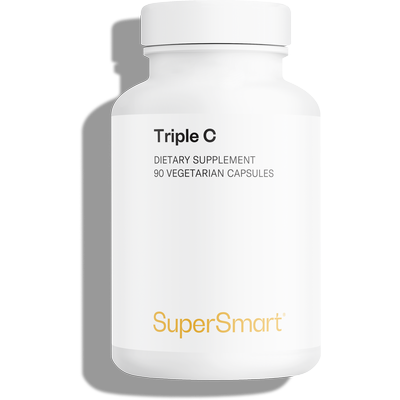The 14 mistakes we make when preparing and cooking food which deprives us of precious vitamins
It’s true – today’s foods contain fewer micronutrients than before. But that’s not the only reason for the wide-scale deficiencies currently affecting countries in the West!
There’s another contributing factor here: knowledge of traditional cooking and preparation methods is no longer being passed on and as a consequence, we’re making more and more mistakes. And when you add them all together, these mistakes are robbing us of precious nutrients …
You’ll see for yourself the extent of this problem by witnessing a typical scene from everyday life, the preparation of a meal, more specifically that of Stéphane and Mathilde, a couple who have invited some friends for lunch. Pay close attention to what happens during their preparations and try to note all the errors made by our two hosts. Believe it or not, there’s a total of 14!
Stéphane and Mathilde have chosen to prepare whiting fillets accompanied by potatoes, spinach, carrots and a tomato salad.
On the face of it, this is a highly nutritious dish. It provides 64.3mg of vitamin C per portion (that’s 58% of the recommended daily amount (RDA)), 249 μg of vitamin B9 (75 % of the RDA), 3.65mg of vitamin E (22 % of the RDA) and around 530mg of omega-3 before preparation.
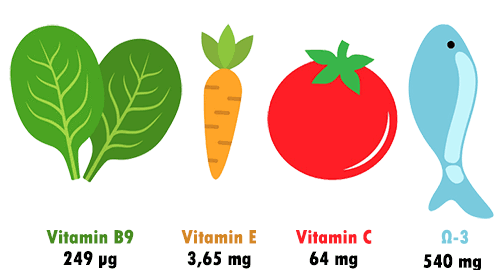
Food preparation: spot the 14 mistakes
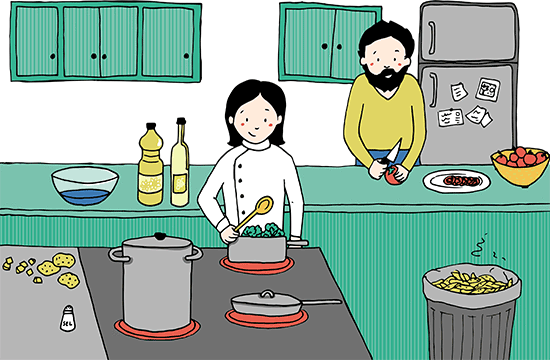
Mathilde begins by preparing the potatoes: she washes them in a large bowl for several minutes to remove any traces of soil, then peels them with a knife and cuts them into small pieces in order to reduce the cooking time and preserve their vitamin content as much as possible. She rinses them again in cold water and puts them in pan of boiling salted water for a good 15 minutes.
During this time, some organic spinach is cooking in a pan of simmering water: Mathilde bought it three days ago direct from the grower as she recently found out that canned spinach is significantly lower in vitamins. Naturally, she’s kept it in the fridge at 4°C to protect it from the heat. She couldn’t find organic carrots so she’s going to use frozen carrots that she bought a few months ago.
Mathilde has also bought some tomatoes that she’s going to serve with a little vinaigrette. She hasn’t kept these in the fridge but in the fruit bowl at room temperature, following a tip she’d read in a magazine. She’ll cut them up just before serving, but everyone will add their own vinaigrette.
Meanwhile, Stéphane is taking care of the whiting fillets which he caught himself last summer. Earlier in the day, he had remembered to take them out of the freezer (2 stars) so that they could defrost slowly in the fridge. As they’re now completely defrosted, Stéphane decides to put them in a previously-heated pan, with sunflower oil suitable for cooking. He cooks them till a light crust forms on the skin then turns them over and carries on cooking them on a low heat.
As is often the case, Stéphane and Mathilde have got their timings wrong: the fish and spinach are cooked several minutes before everything else is ready. Stéphane turns off the heat and covers the pan to keep the fish warm. While he waits, he slices the tomatoes into rounds and puts them in a dish.
When everything is ready, Stéphane puts it all on plates and opens a bottle of white wine.
Did you spot the 14 mistakes that Stéphane and Mathilde made?
1) Removing the skin from the vegetables
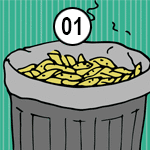 This was their first mistake and definitely the worst: it’s in the skin and the flesh around it that vitamin C and many other micronutrients are found. That’s the case with potatoes and with many other vegetables such as carrots and turnips.
This was their first mistake and definitely the worst: it’s in the skin and the flesh around it that vitamin C and many other micronutrients are found. That’s the case with potatoes and with many other vegetables such as carrots and turnips.
What’s more, the skin exerts a barrier effect during cooking by slowing down the loss of nutrients contained in the flesh.
If you really don’t like the skin, peel the vegetables after cooking.
If you remove the skin because you’re worried about pesticides, choose organically-grown vegetables.
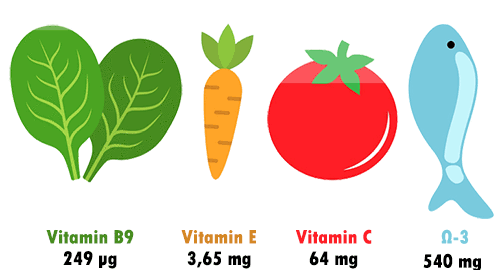
2) Soaking or washing the vegetables in water
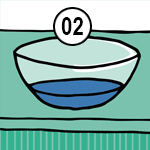 Washing the potatoes (or any other vegetable) in water is a real disaster: even if you do it for just a few minutes, it will encourage the micronutrients to dissolve in the water (1) (as much as 20% of the vitamins may be lost).
Washing the potatoes (or any other vegetable) in water is a real disaster: even if you do it for just a few minutes, it will encourage the micronutrients to dissolve in the water (1) (as much as 20% of the vitamins may be lost).
If the potatoes are dirty, careful brushing followed by a brief wash in cold water will suffice.
3) Cutting the vegetables into pieces
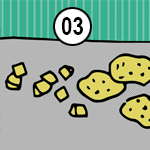 The amount of vitamins lost in the soaking and boiling water depends on the geometry of the vegetable: the higher the ratio between its volume and surface, the greater the loss. In other words, the more a vegetable is cut into pieces, the less it will retain its precious nutrients (2)…
The amount of vitamins lost in the soaking and boiling water depends on the geometry of the vegetable: the higher the ratio between its volume and surface, the greater the loss. In other words, the more a vegetable is cut into pieces, the less it will retain its precious nutrients (2)…
Coarsely chopping potatoes can result in an additional loss of vitamins of 30-50%!
4) Cooking the vegetables in salted water
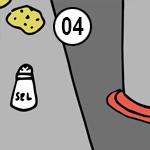 There’s no denying that cooking is bad for vitamins because it accelerates their oxidation and encourages their dissemination into the cooking environment. The aim is therefore to minimise these vitamin losses.
There’s no denying that cooking is bad for vitamins because it accelerates their oxidation and encourages their dissemination into the cooking environment. The aim is therefore to minimise these vitamin losses.
That’s not at all what Mathilde has done: cooking the vegetables in water (and salted water at that) has produced the greatest losses: around 60% of the vitamin C and 50% of the folates in the spinach and potatoes, against just 20-30% when they’re steamed, pan-fried or cooked in the oven.
And the losses increase with the volume of water used and the length of cooking time (3)!
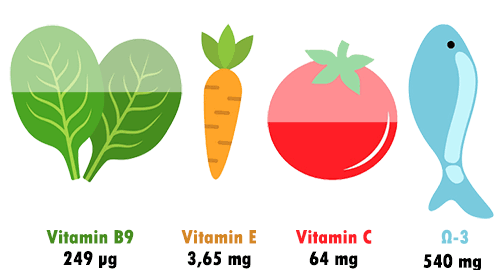
5) Buying the vegetables days before they’re going to be used
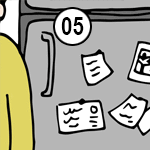 This is undoubtedly something most of us do. Buying all our vegetables at the same time for the next three or four days might be convenient but there’s a dramatic effect on the vegetables’ vitamin content.
This is undoubtedly something most of us do. Buying all our vegetables at the same time for the next three or four days might be convenient but there’s a dramatic effect on the vegetables’ vitamin content.
Consider that after four days, fresh spinach loses half its content in vitamin B9 and almost as much vitamin C. And this obviously applies to all vegetables.
We therefore need to reconnect with the practices of our grandparents – buying fresh, seasonal products, several times a week, ideally direct from the grower or from markets.
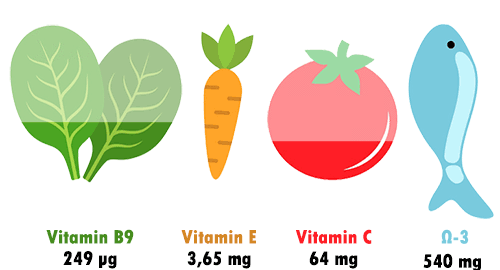
6) Exposing the fruits and vegetables to light
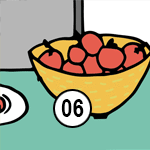 Mathilde was right not to put the tomatoes in the fridge: when they’re stored in a cold place, the genes responsible for creating and maintaining aromatic compounds stop working (4).
Mathilde was right not to put the tomatoes in the fridge: when they’re stored in a cold place, the genes responsible for creating and maintaining aromatic compounds stop working (4).
But they should still be kept out of the light! The antioxidant carotenoids and vitamin E they contain are very sensitive to light so it’s important to cover the box they’re in or put it in a cupboard.
Note: tomatoes are only produced in Europe from May to September. Outside of these months, they are imported and their vitamin content is significantly lower.
7) Cutting the fruits and vegetables in advance
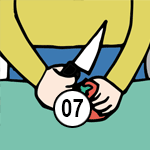 By slicing the tomatoes in advance, Stéphane was saving time. But once more, this has led to a significant reduction in vitamins. Vitamins C and B9, in particular, are highly sensitive to oxygen.
By slicing the tomatoes in advance, Stéphane was saving time. But once more, this has led to a significant reduction in vitamins. Vitamins C and B9, in particular, are highly sensitive to oxygen.
If you can’t cut your tomatoes (or any other fruit or vegetable) at the last minute, toss them in vinaigrette straightaway (it will reduce the tomatoes’ exposure to fresh air and increase their antioxidant defences) and cover them up.
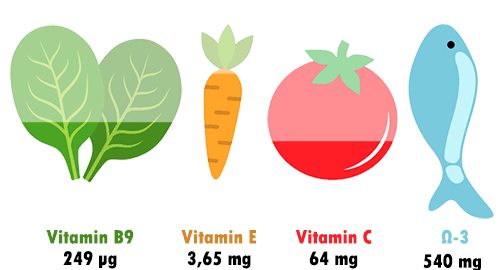
8) Freezing fish in an unsuitable appliance
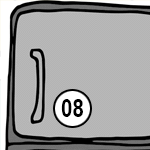 To freeze fish at home you need the right equipment. Using a 2-star freezer (which reaches temperatures of -12°C) will not ensure the quality of your food is maintained in either the short or long term. The temperature is too close to 0 to guarantee rapid freezing: large ice crystals will form in the extracellular milieu of the fish resulting in serious cell damage.
To freeze fish at home you need the right equipment. Using a 2-star freezer (which reaches temperatures of -12°C) will not ensure the quality of your food is maintained in either the short or long term. The temperature is too close to 0 to guarantee rapid freezing: large ice crystals will form in the extracellular milieu of the fish resulting in serious cell damage.
When freezing is rapid, however, (with a 4 star freezer reaching -30°C), the crystals formed are small and uniformly distributed and so tissues are much better preserved.
9) Keeping food in the freezer for too long
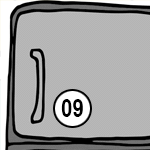 Contrary to what you might think, the vitamin content of food continues to vary after freezing. At a temperature of -12°C, as in the case of Stéphane and Mathilde, the amount of vitamin C lost in the carrots could be as much as 20% after a year in the freezer. Studies show that vitamin B9 is even more fragile: it only takes a few months before levels fall by 50%.
Contrary to what you might think, the vitamin content of food continues to vary after freezing. At a temperature of -12°C, as in the case of Stéphane and Mathilde, the amount of vitamin C lost in the carrots could be as much as 20% after a year in the freezer. Studies show that vitamin B9 is even more fragile: it only takes a few months before levels fall by 50%.
We don’t know precisely how long ago Stéphane and Mathilde bought their carrots but what we do know is that they will have been blanched before being frozen. This process immediately depletes the more fragile vitamins: around 50% of vitamin C and vitamin B9 will have been lost already (5).
Stéphane’s fish will have suffered two other problems: oxidation of lipids (including precious omega-3 fatty acids) which become rancid and harmful to health, and protein aggregation which causes a liquid to exude when it’s thawed. In fact, after six months in the freezer (and even more so in a 2 star freezer) there will no longer be any omega-3 left in the fish (6).
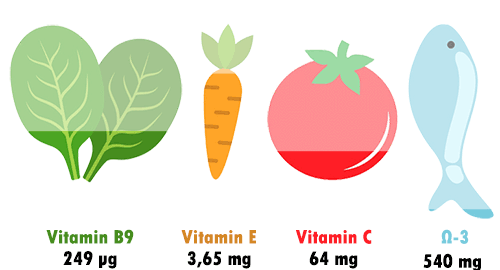
10) Not defrosting a product properly
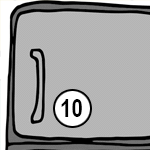 Stéphane has made his 10th error in defrosting his fish in the fridge. This type of slow defrosting causes an aqueous layer to form on the surface of the fish which helps to maintain the product around 0°C for a few hours.
Stéphane has made his 10th error in defrosting his fish in the fridge. This type of slow defrosting causes an aqueous layer to form on the surface of the fish which helps to maintain the product around 0°C for a few hours.
But at this temperature, not only do the ice crystals get bigger, but the vitamins tend to migrate into the watery layer and encourage the development of microorganisms.
It’s therefore better to thaw fish quickly. Stéphane should have defrosted it in the microwave, or in boiling water (in a hermetically-sealed bag) or cooked it without first freezing it.
11) Choosing the wrong cooking oil
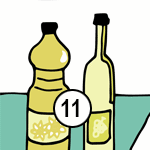 Stéphane has used a sunflower oil, admittedly one suitable for cooking, but which has an omega 6:omega 3 ratio equivalent to 1000 when ideally it should be between 1 and 5.
Stéphane has used a sunflower oil, admittedly one suitable for cooking, but which has an omega 6:omega 3 ratio equivalent to 1000 when ideally it should be between 1 and 5.
He should have chosen rapeseed oil because of its monounsaturated fatty acid content, its high smoking point (the temperature at which the oil degrades and becomes harmful to health) and its positive effect on the omega3:omega 6 ratio – which is especially important as there’s no omega 3 left in the fish.
12) Frying fish in a pan
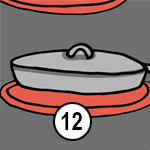 Very high temperatures result in the formation of molecules (acrylamides, heterocyclic amines, polycyclic aromatic hydrocarbons…) which are responsible for the brown crust which forms on the surface of foods.
Very high temperatures result in the formation of molecules (acrylamides, heterocyclic amines, polycyclic aromatic hydrocarbons…) which are responsible for the brown crust which forms on the surface of foods.
While they make food aromatic and appealing, they are unfortunately carcinogenic and have an adverse effect in terms of cardiovascular and inflammatory diseases (7-8)...
13) Keeping the dish warm
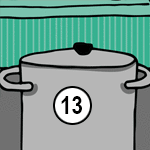 Our couple’s lack of organisation has meant Stéphane has had to keep the fish and spinach warm for several minutes which will continue to deplete the food’s fragile vitamin content. The worst offenders here are canteens and cafes where dishes are sometimes kept warm for more than an hour.
Our couple’s lack of organisation has meant Stéphane has had to keep the fish and spinach warm for several minutes which will continue to deplete the food’s fragile vitamin content. The worst offenders here are canteens and cafes where dishes are sometimes kept warm for more than an hour.
14) Eating the meal while drinking alcohol
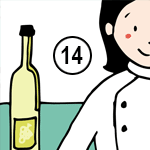 Of course most people consider having a glass of wine with food as a pleasure. But it too can be seen as another mistake: consuming alcohol impairs the absorption of vitamin E as well as several minerals such as magnesium, zinc and iron.
Of course most people consider having a glass of wine with food as a pleasure. But it too can be seen as another mistake: consuming alcohol impairs the absorption of vitamin E as well as several minerals such as magnesium, zinc and iron.
So what can we conclude about Stéphane and Mathilde?
The 14 mistakes they made have resulted in a reduction of around 70% in vitamins C and B9, and a total loss of omega-3, while at the same time exposing them to carcinogens.

To prevent this waste, they should have followed the advice below to the letter:
- Buy your fresh fruits and vegetables just before you intend to use them, ie, several times a week.
- Don’t peel them but cook them intact whenever possible.
- Store them in the fridge or away from light, in bags or containers that protect them from oxygen.
- Cut up fruits and vegetables just before eating.
- Cover chopped vegetables or drizzle them with vinaigrette or lemon juice.
- Use a brush to clean them and put them briefly under running water.
- Avoid cooking them in water or keep the cooking water to use in another dish (a soup for example).
- Don’t leave hot dishes hanging around.
- Avoid reheating dishes several times.
- Only freeze foods if you have a suitable freezer (that reaches -30°C) and don’t keep them too long in the freezer (fish should not be kept for longer than a month).
- Defrost foods quickly (in the microwave, for example).
- Choose the right cooking oils.
If you follow all this advice and eat plenty of fruit and vegetables every day, you stand a good chance of reaching optimal daily levels of vitamin C and folates, the two most fragile vitamins. It must be said, however, that this is by far from the norm…
Our habits and lifestyles (too little time, our preference for supermarkets, imports of raw materials from the other side of the world, preserved ready-meals, industrialised farming …) have increased the prevalence of strong>deficiencies in several essential micronutrients such as vitamin B9 and vitamin C.
To the point where the idea of providing the whole population with additional vitamin B9 is gaining traction, like vitamin D-fortified milk or fluorine-fortified salt. Almost 40% of pregnant women already receive vitamin B9 supplements (9) to minimise the risk of birth defects.
In 2010, the EFSA recognised the benefits of vitamin B9 supplements for reducing fatigue and optimising the immune system, mental health, and the body’s overall function (synthesis and use of proteins, cell division, energy metabolism etc.) (10).
Bibiliography
- Leskova E et al. Vitamin losses: Retention during heat treatment and continual changes expressed by mathematical models, Journal of Food Composition and Analysis, Volume 19, Issue 4, June 2006, Pages 252-276
- Holasova M et al. Determination of folates in vegetables and their retention during boiling, Czech Journal of Food Sciences 26(1):31-37 January 2008
- Causeret J. (1986) Caractéristiques nutritionnelles et bon usage de nos aliments. In : L'alimentation humaine. Evolution et tendances. Documents INRA P 60, Dijon, 1 - 15
- Bo Z et al. Chilling-induced tomato flavor loss is associated with altered volatile synthesis and transient changes in DNA methylation, Proc. Natl Acad. Sci USA 113,12580–12585 (2016). doi: 10.1073/pnas.1613910113
- Effet de la congélation sur les antioxydants naturels dans quelques légumes et fruits / L. Hanna ; sous la direction du Dr A. Bassal. — Extrait de : Annales de recherche scientifique. — N° 4 (2003), pp. 121-132.
- Combe N. Stabilité des Omega 3 selon les modes de chauffage et de conservation, Médecine et Nutrition, 2003-1, Vol. 39 (1), p. 9-14
- J. Uribarri, W. Cai, O. Sandu et al., “Diet-derived advanced glycation end products are major contributors to the body's age pool and induce inflammation in healthy subjects,” Ann nyAcad Sci, 2005 Jun;1043:461-6.
- Peppa M, Cai W, Goldberg T, Lu M, He C, Vlassara H. Restriction of dietary glycotoxins reduces excessive advanced glycation end products in renal failure patients. J Am Soc Nephrol. 2003 Mar;14(3):728-31.
- Anses, Vitamine B9 ou acide folique, https://www.anses.fr/fr/content/vitamine-b9-ou-acide-folique
- EFSA opinion références 2009;7(9):1213 & 2010;8(10):1760
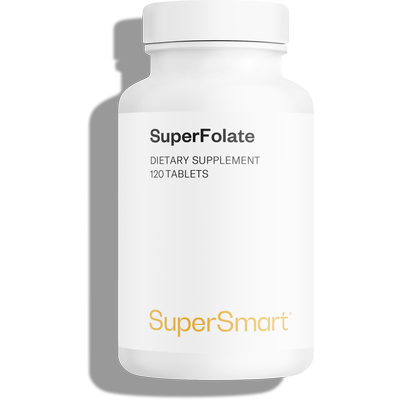
A new generation of folic acid recognised as safe and effective by the EFSA and FDA
www.supersmart.comAll rights reserved
Free
Thank you for visiting our site. Before you go
REGISTER WITHClub SuperSmart
of exclusive benefits:
- Free: our weekly science-based newsletter "Nutranews"
- Special offers for club members only



